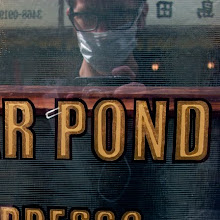The January highlights of the W.Chelsea gallery scene — Anthony McCall's 'sculpted light' projections at Sean Kelly and the California Minimalists group show at David Zwirner, whose acrylic lozenges, fiberglass wedges, and projected-light prisms belied their weighty emotive tendencies — are supplemented by heavy vibes of a more readily perceivable sort. As in: heavy metal. I mean the one-two shot of Robert Grosvenor at Paula Cooper and Sterling Ruby at Pacewildenstein. Both artists, the younger Cali-based Ruby and the stalwart NYer Grosvenor, contribute unmistakably affective works in two unmissable exhibitions.
Ruby's first installation at Pacewildenstein is a lovely gut-punch: two new roughly same-scale works frankly titled BUS and PIG PEN. The former, newer piece is just that: a reconfigured bus (if the corroded outside advert is any clue, it used to be a Monster Energy Drink vehicle) screened w/ a latticework of metal security doors on the outside and inside. Ruby kept the driver's seat, mirrors, and various bus-related detritus here and there, but otherwise the narrow interior was gutted in favor of the cages, which one might imagine could house either detainees or refrigerated lockers for the illicit body-part trade. The back quarter of the bus — what I am calling the 'VIP Area' — has leather seats but also a ridiculous array of subwoofers and chrome hemispheres. It's like that flatbed truck in Luis Gispert's short film 'Smother' (which premiered at Mary Boone Gallery two years ago), when the kid is like biking alongside it and the flatbed is lined w/ massive speakers blasting quintessential Miami booty bass and one big dude, cross-armed, staring the kid over. PIG PEN is basically a bus-sized gridlock of rusty metal security gates, welded into rectangular blocks and stood either end-to-end or on their sides. One vertical block is doorless, and should you choose to stand inside it note I am about 5'8" tall and could just stand vertically inside it. Now transpose this menacing grid into contemporary society and solitary confinement cages, and let that simmer for a bit in your subconscious.
Anyone who told you assemblage is just inconsequential agglomerations of mix-matched detritus, prone to tipping over and certainly not worthy of producing a deep impact obviously isn't familiar w/ Grosvenor. And while I feel his more recent works are a bit too clean and balanced, his vintage sculpture — three of which are on display at Paula Cooper — are where it's at: industrial, raw, and somehow just treading the border between elegant and violent. His piece from '89 at last year's group show stole my attention away, practically insinuating itself and its tank-like cinderblock slab in the room, sucking the life out of the other pieces. Grosvenor is a tricky addition to group exhibitions: his style dominates; unlike, say, a twisted-steel John Chamberlain or a steel and neon assemblage from Keith Sonnier, where you can observe then turn away, Grosvenor's hinder this flighty discernment. As in: when a Grosvenor assemblage is in the room there's NOTHING ELSE in the room, unless that happens to be another Grosvenor. In this show, the '86 assemblage takes the rough-hewn painted steel curtain (a recurring Grosvenor element), and creates a canopy supported on four sides by rusty steel disks, like badass saw-bladed enlarged 500x. This shelter houses a portion of a concrete wall, displayed on a blue work-tarp like some gigantic dinosaur fossil. It manages to recall both archaeology and transit while appearing as nothing you've ever seen before. The '91 piece also has a canopy, a translucent fiberglass form staked above what appears to be a rusted off-green-colored car hood. Richard Prince's readymade skewered by a metal pole. '94 maintains this brutal hand in what appears to be a surfboard-shaped welded steel conglomerate, resting on a plank of affixed industrial tubes that hover above a silvery low hemisphere like a torn-off piece of a circa-'50s UFO. It's the most ostentatious of the three, and not just due to the silver. For me, this piece in particular is the demarcation b/w Grosvenor's solid early works and his more fully-formed, more studied, more, ah, perfect later assemblages. That said, '94 is a nicely unpolished one.
So get in there, immerse yourself w/ the heavy metal.
skip to main |
skip to sidebar

